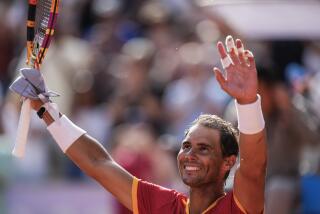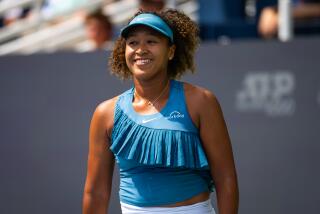Connors, Evert and Navratilova Aren’t Conceding Anything Yet
- Share via
PARIS — Sixteen years ago, a blond teen-ager with a ponytail in her hair and ice water in her veins, took the U.S. Open by storm. Her name was Chris Evert, and when she two-fisted her way into the semifinals, she became an immediate sensation.
Since that debut, teen-age tennis players have been the rage, whether they were named Austin or Jaeger or McEnroe or Becker or Graf or Sabatini. Steffi Graf played in the French Open when she was 13. Gabriela Sabatini reached the semifinals at 15. Boris Becker won Wimbledon at 17. The list goes on.
But now there is a new fad in tennis: Older players. Baby faces are everywhere--so grizzled ones are to be savored. It’s not that Jimmy Connors (34), Guillermo Vilas (34), Evert (32), Martina Navratilova (30), or even Ivan Lendl (27) need pacemakers. They just know that the end is nearer--in some cases much nearer--than the beginning because their bodies tell them so.
“I still feel like I can get my opponents tired during a match,” Evert said. “Sometimes I sense that when it’s tight. But I know my recovery time the next day is going to be longer; that if I have to come back and play the next day, it will be tough.
“Now, after I play I go and ice in about four different places--I won’t tell you where--and then I take anti-inflammatories for my knees and I’m real conscious of getting my rest. Ten years ago I never even thought about any of those things. I just played. You have to be conscious of all these things if you want to keep playing and playing well. It gets a little harder to do every year.”
But they do it. They do it because the money is extraordinary. They do it because they’ve done it all their adult lives. They do it because they can still do it well. But most of all they do it because they understand that when they stop, their lives will never be the same.
What is remarkable about the veterans still on tour is how often they seem to outlast opponents. Part of this is certainly mental. When a younger player senses that one of the game’s icons is still strong late in a match, there is a tendency to wilt. But part of it is conditioning.
“I got tired towards the end and he can run forever,” Ricki Osterthun said after losing to Connors Monday. “Everyone in the locker room knows that no one is in better shape than Connors.”
That isn’t quite true. At 34 Connors is not in the shape he once was. After playing 3 hours 40 minutes in the second round last week, Connors sipped a postmatch beer (only one) and shrugged. “If they schedule me tomorrow,” he said. “I might as well get on a plane to London.”
More than Evert or Navratilova, Connors is not the player he once was. While they remain almost unbeatable in the women’s game, Connors has clearly slipped. After 13 years in the world’s top four, he dropped to No. 8 last year. He was beaten in the first round at Wimbledon by Robert Seguso and in the third round at the U.S. Open to Todd Witsken. He has not won a tournament since October 1984. He has reached eight finals during that time--in three of them an injury forced him to retire from the match.
Last Wednesday, he played good tennis against Becker and lost. At this point if Becker and Connors both play well, Becker will win.
“But I can still beat a lot of guys,” Connors said. “In fact, on certain days, I can still beat most guys. I still enjoy the tennis. I don’t enjoy all the stuff off the court, but I do enjoy getting out there and playing. As long as I feel as if I can compete and as long as I enjoy it, why shouldn’t I play? This is the way I make my living and it’s a very good living.”
For some that is not enough. Bjorn Borg quit at 26 when he decided he could not overtake John McEnroe to be No. 1 again. McEnroe at 28 has found life as the No. 7 player in the world much tougher than life as No. 1. One senses that both Evert and Navratilova, who have been on top for so long--Evert was first ranked No. 1 in 1974, Navratilova reached No. 2 a year later--would not be able to do what Connors is doing.
“I’ve thought about that a lot,” Navratilova said this week. “I’m looking forward to my life after tennis, and I know there is one. But in the meantime I want to raise hell while I still can.
“When I quit, I want to see the places I’ve been going to all these years. You know I’ve never been inside the Louvre. I want to go the Taj Mahal and Nepal. I want to see whales and penguins. There’s a lot I haven’t done because I’ve been playing tennis.
“There’s definitely a part of me that would like to go out in a blaze of glory like Greta Garbo. Quit while I’m right on top. Just totally cut it off. But I don’t know if I can do that. Sugar Ray Leonard has retired four times. Billie Jean King came back a few times. It isn’t easy. You never know if you’ll be able to stop. And, if I still enjoy it, so what? Why stop?”
What usually stops them is an injury. Evert (who has found time to go to the Jeu de Pomme but never the Louvre) had her first real injury last fall, a bad knee. That, combined with turmoil in her personal life, kept her off the tour for five months. But she came back, her knee fixed, happy with a new boyfriend and, according to other players, playing about as well as ever.
“I’ve been hearing that Chris is on her last legs since 1978 when she beat me in the Open final,” said Pam Shriver. “The problem is she’s a centipede. As long as she has the streak of winning a Grand Slam every year (13) I don’t see how she can quit. Martina is still No. 1 in the world. And, as long as they have each other out there, they have motivation. The two of them have really messed things up for me hanging around this long.”
There are some who say that they have hurt women’s tennis by being dominant for so long. There is truth to this in that there was little suspense for a while: between 1981 and 1985, starting with the Australian Open and ending with the U.S. Open, they won every Grand Slam title.
But now with the end at least on the horizon if not clearly in sight, their departure worries tennis people.
Steffi Graf, the likely successor to the throne, is no less single-minded and driven than Evert or Navratilova but for now lacks their charisma and humor. Gabriela Sabatini, the other princess, has yet to grow into the role of a superstar.
That may come for both of them. It may not. Either way, no one is pushing Evert and Navratilova out the door. They still lend great excitement to the game.
The same is true of Connors and even Vilas, who will be 35 in August. His ranking has dropped in the last year from 18 to 45. But he has been written off so many times that saying he is finished could still be premature.
“I can still play good tennis,” he said. “I get hurt more easily and need longer to recover, but I’m still in good shape. Maybe I’ll play 10 more years. I hope so anyway.”
No one is in better shape right now than Lendl. He is at his peak at 27 yet says he too must work harder each year to maintain his edge. “Fortunately, I still enjoy it,” he said. “In fact, except for lifting weights, I think I enjoy training to play tennis more than I actually enjoy playing tennis. I’m lucky that way.
“If I didn’t see results from the work it would be very upsetting. But I do. There are times when you are winning a lot when you might get bored a little. When you lose, you get hungry again. If I’ve been winning, I look for little things to get me going. Like maybe I don’t like the guy I’m playing a little bit. Or, maybe someone said something or wrote something that made me angry. Mostly, anger helps me.”
Anger helps them all. The young ones have goals--winning a Grand Slam title, winning Wimbledon, being No. 1. The older ones have done all that so they set different goals. “Sometimes I look in the stands for a writer who has said something about me I didn’t like,” Navratilova said. “And I say to myself, ‘I’ll prove him wrong.’ You look for any edge you can find.”
At least right now, the old hands still find those edges. And the people who have watched them for years and years are delighted. Like the players, they know the end must come and the court turned over to the Beckers and Grafs and Sabatinis and Edbergs.
But not just yet.
More to Read
Go beyond the scoreboard
Get the latest on L.A.'s teams in the daily Sports Report newsletter.
You may occasionally receive promotional content from the Los Angeles Times.










